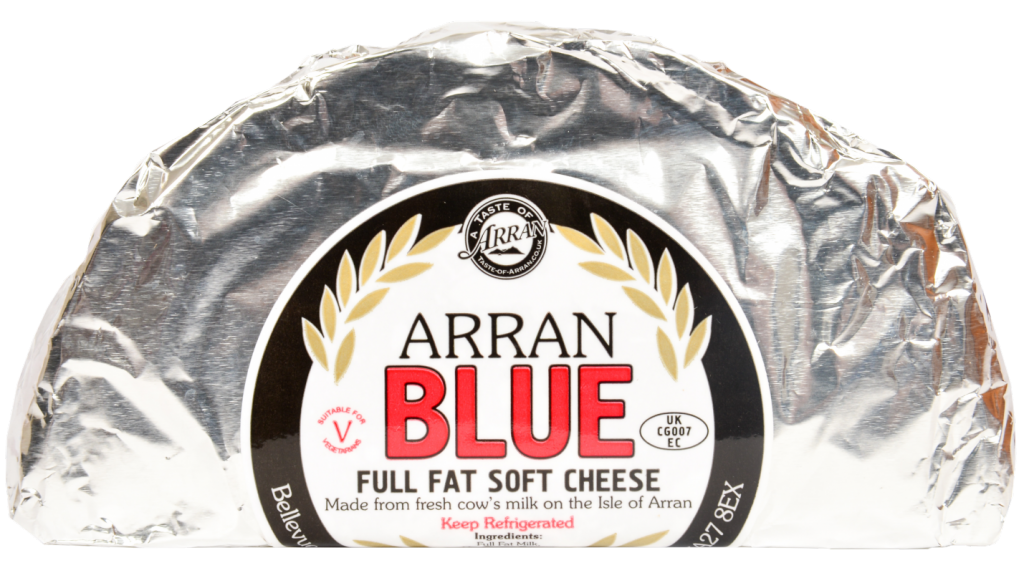Blue Cheese
Blue cheese or bleu cheese is cheese made with cultures of the mold Penicillium, giving it blue spots or veins. This carries a distinct smell, either from that or various specially cultivated bacteria. Some blue cheeses are injected with spores before the curds form, and others have spores mixed in with the curds after they form. Blue cheeses are typically aged in a temperature-controlled environment such as a cave. Blue cheese can be eaten by itself or can be spread, crumbled or melted into or over a range of other foods.
Blue cheese is believed to have been discovered by accident when cheeses were stored in natural temperatures and moisture-controlled caves which happen to be favorable environments for many varieties of harmless mold. It was moist in the cave so the mold would form. According to legend, one of the first blue cheeses, Roquefort, was discovered when a young boy, eating bread and ewes' milk cheese, abandoned his meal in a nearby cave after seeing a beautiful girl in the distance. When he returned months later, the mold (Penicillium roqueforti) had transformed his cheese into Roquefort.
Gorgonzola is one of the oldest known blue cheeses, having been created around AD 879, though it is said that it did not contain blue veins until around the 11th century. Stilton is a relatively new addition, becoming popular sometime in the early 1700s. Many varieties of blue cheese that originated subsequently, such as the 20th century Danablu and Cambozola, were an attempt to fill the demand for Roquefort-style cheeses that were prohibitive due to either cost or politics.
Text taken from : https://en.wikipedia.org/wiki/Blue_cheese

Arran Blue
Bellevue Creamery, Isle of Arran
Bellevue produces Arran Blue from the milk of Arran cows. These cheeses have won awards around the globe including a Gold medal for the Arran Blue at the World Cheese Awards in 2011. This semi soft blue is similar in style to the French ‘Blue de Auvern’ - a pasteurised cow’s milk cheese with a mild, salty flavour when young, maturing to a tangy cheese.
Rennet : Vegetarian
Milk : Pasteurised Cow's

Blue Murder
Highland Fine Cheeses, Tain
Scotland's original cube-shaped cheese!
A firm textured, salty, creamy, mild blue cheese with a metallic tang on the palette. Loved by afficanados and new-comers to blue cheese alike
Rennet : Vegetarian
Milk : Pasteurised Cow's

Strathdon Blue
Highland Fine Cheeses, Tain
The more classically style blue cheese produced by Highland Fine Cheeses. Mild and creamy but with a recognisable peppery blue cheese flavour that can become quite pronounced as the cheese matures.
Rennet : Vegetarian
Milk : Pasteurised Cow's

Lanark Blue
Errington Cheeses, Lanarkshire
Matured for six weeks (early season) and for up to 8 months for Christmas time / Burns night. As the sheep are only milked from January to September, seasonal variations in the cheese will be found. Spring cheese will be fresh and sweet with the blue veins providing a light blue flavour while cheese for Christmas/ Burns night will be more powerful becoming more pungent.
Rennet : Vegetarian
Milk : Unpasteurised Sheep's

Hebridean Blue
Sgriob Ruadh, Isle of Mull
A hard, crumbly blue cheese with a strong peppery spice. At times can be slightly creamier than crumbly, strength is usually very easy to tell between different batches just by visual inspection. What you see is what you get when it comes to strength. Often referred to as a "Scottish Stilton", without a doubt the strongest Scottish blue cheese.
Rennet : Animal
Milk : Unpasteurised Cow's

Biggar Blue
Errington Cheeses, Lanarkshire
Biggar Blue was created in the 2019 as a sister to cheese to the Errington’s famous Lanark Blue (made with sheep’s milk); made similar to the Lanark (based on a Roquefort recipe) but with goats milk it has a floral note to accompany the blue flavour.
Rennet : Vegetarian
Milk : Unpasteurised Goat's